An exchange rate is a metric by which the value of one currency is compared to another. It can be thought of as a measure of how much of the second currency can be "bought" with an amount of the first currency. Exchange rates are determined by supply and demand in the foreign exchange market and can fluctuate over time. They play a crucial role in international trade and finance, influencing the cost of imports and exports, as well as the profitability of foreign investments. Exchange rates are commonly expressed as a ratio, such as how many units of one currency are needed to acquire one unit of another currency. The purpose of an exchange rate is to figure out the buying power of a currency as compared to another currency. Not all currencies have the same buying power per unit, so knowing the exchange rate helps determine the "value" of an amount of money. For example, if the exchange rate of US dollars (USD) to Pound sterling (GBP) is 1.29. This means that it takes $1.29 to equal £1. Put another way, if a US citizen traveled to the UK with $10,000 to exchange into pounds, they would get about £8,034. Exchange rates enable businesses and individuals to convert currencies and engage in cross-border trade. When a country's currency depreciates against another, its goods and services become relatively cheaper for foreign buyers, boosting exports. Conversely, when a currency appreciates, imports become more affordable. Exchange rates impact the value of foreign investments and assets. If an investor holds investments denominated in a foreign currency, fluctuations in exchange rates can affect the returns and overall value of those investments. Central banks may adjust interest rates or intervene in foreign exchange markets to manage the value of their currency. By influencing the exchange rate, central banks can impact exports, imports, and the overall domestic economy. If a country experiences a large trade deficit, a depreciation of its currency can make its exports more competitive and reduce the trade imbalance. Conversely, if a country has a trade surplus, an appreciation of its currency can make imports more affordable and help rebalance the trade. Exchange rates, though seemingly abstract, are firmly grounded in economic fundamentals. Factors such as inflation, interest rates, and economic growth are major determinants. Lower inflation rates typically boost a country's currency as purchasing power is retained. Conversely, higher inflation often depreciates currency value. Interest rates too, wield influence. When a country raises its interest rates, it could attract foreign capital, thereby bolstering its currency. Finally, robust economic growth can lead to currency appreciation as it signals a healthy, productive economy. Yet, the interplay of economic factors isn't always straightforward. For instance, if high interest rates are accompanied by runaway inflation, the currency might not necessarily strengthen. Or, strong economic growth could lead to currency depreciation if it stokes inflation fears. This complexity underscores the need for nuanced understanding when analyzing the impact of economic factors on exchange rates. The influence of political factors on exchange rates cannot be understated. Stability is a cherished political attribute that often attracts foreign investment, leading to currency appreciation. By contrast, political turmoil or uncertainty can trigger capital flight, causing the currency to depreciate. Changes in government policy, such as monetary or fiscal measures, can also sway exchange rates. However, the correlation between political factors and exchange rates isn't always linear. Certain political events, such as elections, might have a temporary impact on the exchange rate, which may eventually revert to its long-term trend. Additionally, a politically stable country with weak economic fundamentals might still see its currency depreciate. This complexity adds to the challenge of forecasting exchange rates based on political factors. Apart from domestic economic and political factors, external events and conditions can significantly influence exchange rates. For instance, changes in international trade relations, global commodity prices, or global economic conditions can shift exchange rates. A rise in oil prices, for instance, could appreciate oil-exporting countries' currencies and depreciate oil-importing countries' currencies. While external factors can be influential, their impact is often intertwined with domestic conditions. For instance, a global economic downturn might have different effects on countries depending on their economic resilience and policy responses. Similarly, changes in trade relations might affect exchange rates differently based on the countries' trade composition and competitiveness. This makes the task of predicting exchange rates based on external factors a complex endeavor. The dynamics of exchange rate determination vary greatly across different exchange rate regimes. In a floating exchange rate system, rates fluctuate freely in response to market forces of supply and demand. If demand for a currency exceeds its supply, its value will rise. Conversely, if supply exceeds demand, its value will fall. This self-regulation brings about automatic balance-of-payment adjustments and lends more flexibility to the economy. However, a floating exchange rate system isn't without its drawbacks. The system can give rise to speculative attacks, causing significant exchange rate volatility. It can also lead to competitive devaluation, where countries intentionally devalue their currencies to gain a trade advantage. These pitfalls underscore the need for sound macroeconomic policies and financial regulation in countries adopting a floating exchange rate system. Contrastingly, in a fixed exchange rate system, the value of a currency is pegged to another currency or a basket of currencies, or sometimes, a commodity like gold. The central bank ensures that the exchange rate stays close to the pegged value by buying or selling domestic currency in the foreign exchange market. This system provides exchange rate stability and predictability, which can foster trade and investment. However, a fixed exchange rate system comes with its own set of challenges. Maintaining the peg can strain a country's foreign exchange reserves and lead to balance-of-payment crises. It can also limit the central bank's ability to use monetary policy to manage the domestic economy. These challenges suggest that a fixed exchange rate system may not always be suitable, especially for countries with volatile economies or weak financial systems. A hybrid of the two is the managed floating exchange rate regime, where the currency value is largely market-determined, but the central bank occasionally intervenes to prevent excessive volatility or misalignments. This regime attempts to combine the flexibility of floating rates with the stability of fixed rates, which can be beneficial for countries with open economies and sizable foreign exchange flows. However, a managed float also has its intricacies. Finding the right balance between market forces and intervention can be challenging, and poorly timed or excessive interventions can distort market signals and create moral hazard. Despite these complexities, a managed floating regime, when well-implemented, can serve as a pragmatic solution in a world of evolving economic circumstances. Transaction risk arises from changes in exchange rates between the initiation and settlement of a transaction. This can affect businesses engaged in international trade, as exchange rate movements can change the cost or revenue in the home currency. Although transaction risk can seem unpredictable, businesses can mitigate it using a variety of strategies. These include using forward contracts to lock in the exchange rate for future transactions, or invoicing in their home currency to pass on the risk to the foreign customer. Despite these mitigation measures, transaction risk remains a pervasive concern in international business. Another type of risk is translation risk, which comes into play when a company has foreign subsidiaries. In consolidating the financial statements, the assets, liabilities, income, and expenses of foreign subsidiaries must be converted into the parent company's currency. Fluctuating exchange rates can lead to discrepancies in the translated amounts, affecting the company's consolidated financial statements. Translation risk, while inherent in multinational operations, can be managed in several ways. For instance, a company can take out loans in the foreign currency to create a natural hedge, or use derivatives to hedge the exchange rate risk. While these strategies can mitigate translation risk, they can't eliminate it, emphasizing the need for prudent financial management in multinational companies. The third type of risk, economic risk, has wider implications. It refers to the potential impact of exchange rate movements on a company's future international earning power. A significant exchange rate shift could affect the competitiveness of a company's products in international markets, thereby affecting its revenues and profits. Managing economic risk requires a strategic approach. This could involve diversifying the markets a company operates in to spread the risk, or adjusting the product mix or pricing to account for exchange rate changes. While economic risk can't be completely eliminated, strategic planning and risk management can help companies navigate its uncertainties. The crux of managing exchange rate risk lies in hedging techniques. They include financial contracts such as forward contracts, futures, options, and swaps. These instruments allow companies to lock in a specific exchange rate for a future date, thus mitigating the risk of unfavorable exchange rate movements. Additionally, they can provide the flexibility to benefit from favorable movements, depending on the type of instrument used. However, hedging is not a one-size-fits-all solution. Different hedging techniques offer different levels of protection and flexibility, and come with their own costs and complexities. Therefore, companies need to assess their specific risk exposure, risk tolerance, and strategic objectives when choosing their hedging strategy. Diversification is another useful strategy for managing exchange rate risk. By spreading investments or operations across different countries and currencies, a company can offset losses in one market with gains in another. Diversification can also reduce the risk of a single currency's movement affecting the company's overall performance. While diversification can be an effective risk management strategy, it is not without challenges. Companies need to consider factors such as market characteristics, regulatory environment, and cultural differences when diversifying into foreign markets. Moreover, diversification can increase complexity and costs, underscoring the need for careful planning and execution. Netting and offsetting are techniques often used by multinational corporations to manage exchange rate risk. Netting involves consolidating and offsetting receivables and payables across different subsidiaries, thereby reducing the number of transactions and the associated exchange rate risk. Offsetting involves structuring operations or investments in a way that the exposure to a particular currency is balanced by an opposite exposure. While these techniques can be effective, they require a high level of coordination and sophisticated financial management. Moreover, they may not be suitable for all types of risk or all companies. Therefore, companies should carefully evaluate their risk profile and operational capabilities before implementing these techniques. Several factors influence exchange rates. Most exchange rates are free-floating, meaning they rise and fall in accordance with fluctuations in supply and demand in the foreign exchange market. Other currencies may be pegged, meaning that their value is tied to the value of another currency within a certain margin; the Hong Kong dollar, for example, is pegged to the US dollar at a range of 7.75 to 7.85, so its value will stay within this range of the USD. Some currencies have different exchange rates depending on whether or not the funds are held inside or outside a country's borders. The Chinese Yuan (CNY), for instance, has an exchange rate of ¥7.05 per $1 outside its borders, but ¥7.04 per $1 inside. Exchange rates are the metric by which the value of one currency is compared to another, and are crucial in finance for determining currency values and purchasing power. Various factors, including economic, political, and external influences, contribute to the fluctuations in exchange rates. Economic factors such as interest rates, inflation rates, and economic indicators impact currency values, while political stability and government policies also play a significant role. External events like changes in international trade relations and global economic conditions further affect exchange rates. The determination of exchange rates varies across different systems, including floating, fixed, and managed floating exchange rate regimes, each with its own advantages and challenges. To manage exchange rate risk, strategies such as hedging techniques, diversification, and netting and offsetting are employed. Understanding and effectively navigating exchange rates are essential for individuals and businesses operating in the global financial landscape.Define Exchange Rate in Simple Terms
What Does Exchange Rate Mean in Finance?
Purpose of Exchange Rates
Facilitates International Trade
Determines the Value of Foreign Investments
Supports Monetary Policy
Promotes Economic Stability
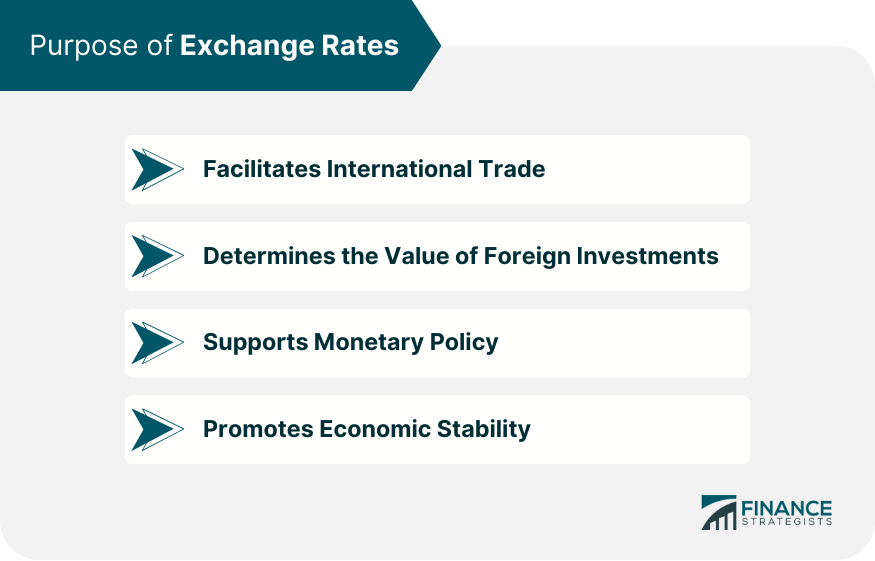
Factors That Influence Exchange Rates
Economic Factors
Political Factors
External Factors
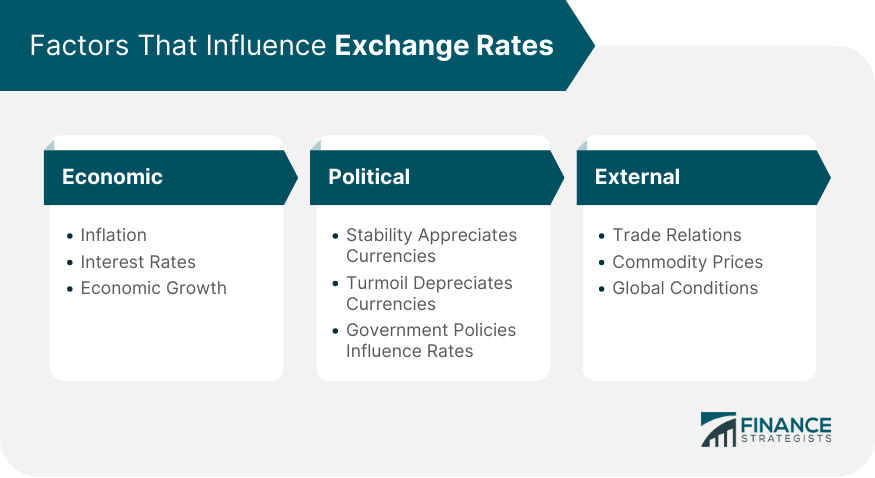
Exchange Rate Determination
Floating Exchange Rate System
Fixed Exchange Rate System
Managed Floating Exchange Rate Regime
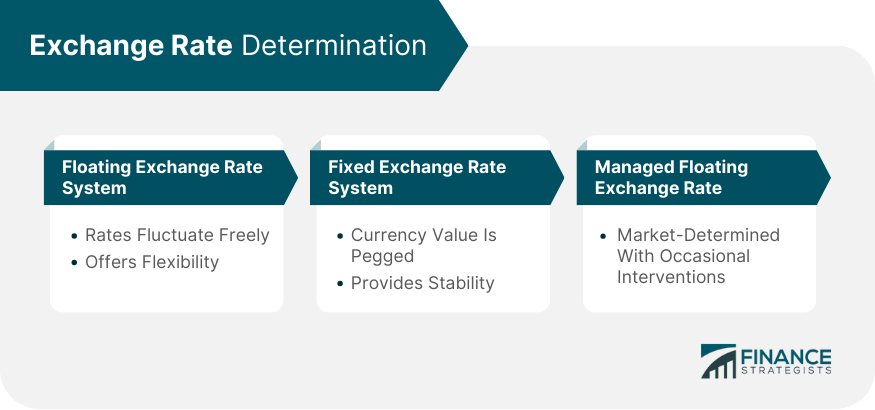
Types of Exchange Rate Risk
Transaction Risk
Translation Risk
Economic Risk
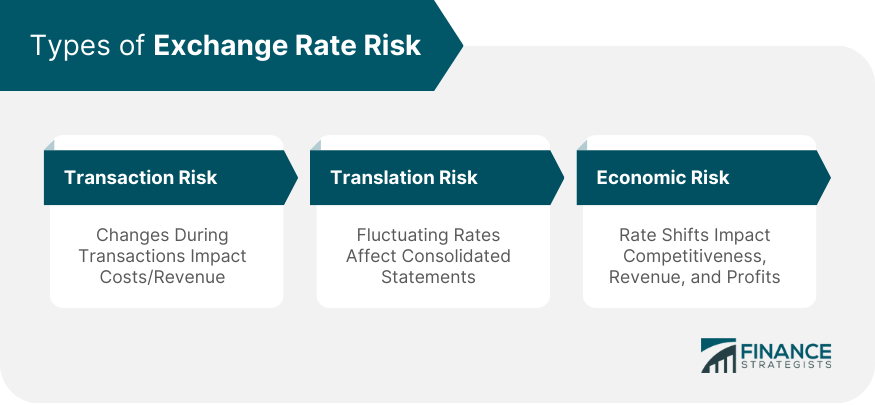
Strategies for Managing Exchange Rate Risk
Hedging Techniques
Diversification
Netting and Offsetting
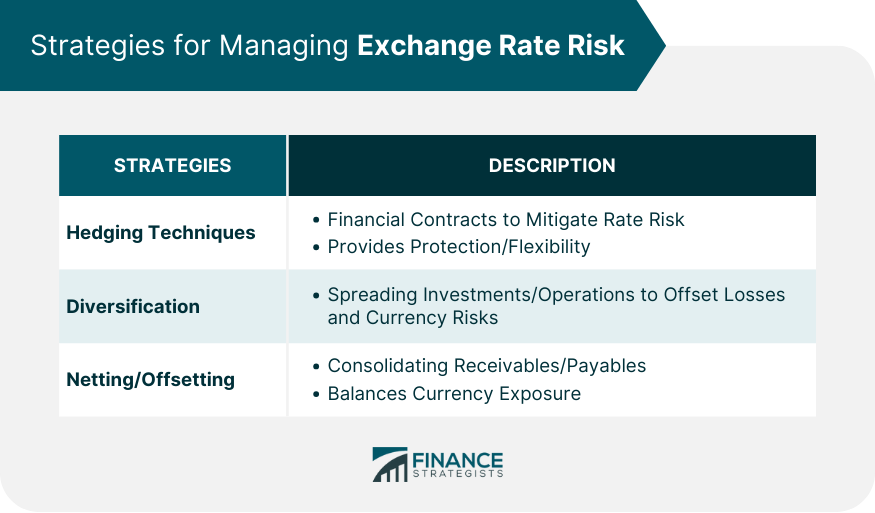
Exchange Rate Example
Conclusion
Exchange Rate FAQs
An exchange rate is a metric by which the value of one currency is compared to another.
The purpose of an exchange rate is to figure out the buying power of a currency as compared to another currency.
Not all currencies have the same buying power per unit, so knowing the exchange rate helps determine the “value” of an amount of money.
Some currencies have different exchange rates depending on whether or not the funds are held inside or outside a country’s borders.
For example, the exchange rate of US dollars (USD) to Pound sterling (GBP) is 1.24. This means that it takes $1.24 to equal £1. Put another way, if a US citizen traveled to the UK with $10,000 to exchange into pounds, they would get about £8,034.
True Tamplin is a published author, public speaker, CEO of UpDigital, and founder of Finance Strategists.
True is a Certified Educator in Personal Finance (CEPF®), author of The Handy Financial Ratios Guide, a member of the Society for Advancing Business Editing and Writing, contributes to his financial education site, Finance Strategists, and has spoken to various financial communities such as the CFA Institute, as well as university students like his Alma mater, Biola University, where he received a bachelor of science in business and data analytics.
To learn more about True, visit his personal website or view his author profiles on Amazon, Nasdaq and Forbes.















